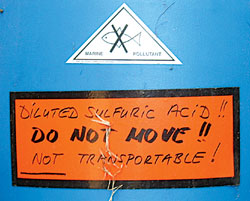 It's 10 in the morning in Amlekhganj. The sun is out, the birds are chirping and there's a soft tarai breeze in the air. Children walk along the side of the highway headed towards Nepal Smriti High School. It's a peaceful, bucolic setting.
It's 10 in the morning in Amlekhganj. The sun is out, the birds are chirping and there's a soft tarai breeze in the air. Children walk along the side of the highway headed towards Nepal Smriti High School. It's a peaceful, bucolic setting.
The only thing out of place is the warehouse right in front of the school. The 50-year-old building once belonged to the now defunct Birganj-Amlekhgunj railway but for more than a decade has been used to store almost 51 metric tons (MT) of poisonous and obsolete pesticides, in violation of the law banning storage of chemicals in a densely populated area.
Some of the pesticides here belong to the Dirty Dozen group of chemicals that are so poisonous that they are banned in most parts of the world. Huge skull-and-bones signs in red on the walls warn of the danger. Every summer children at the nearby school complain of headaches, stomach pains, nausea and even vomiting.
An open gate leads to a small compound in front of the warehouse, which appears to have been used as a public latrine. The building's doors are all padlocked and cracks have appeared in the walls. By now most of the older children know what's inside after watching a documentary screened by an environmental group. "A lot of us get ill when the wind starts blowing in the summer," complained one ninth grader.
In 2001, Greenpeace visited Amlekhganj, Khumaltar in Kathmandu and other sites to make the pesticides safe by packing them in tightly sealed protective containers. Today the younger students blithely use the walls of the warehouse as play props.
For 50 years warehouses like these across the country have stored obsolete pesticides like DDT imported during the late 1950s and 1960s for farming and malaria eradication. By the late 1980s, it was clear that the large stocks of unmanaged materials posed a serious threat to the people and the environment around these storage areas.
UNDP, the Asian Development Bank and the World Bank have helped inventory the storage sites. At least 100-150MT of the chemicals were 'safely disposed' of by companies such as New Zealand-based ANZDEC Limited in the late '80s.
But a report prepared by the Nepal Forum of Environmental Journalists Pesticides Watch Group (PWG) in June 1993 criticised the disposal method used: burying or spraying the toxic chemicals in jungles and even plans to incinerate them in the Hetauda Cement Factory. Thankfully, after the intervention of Greenpeace and the media, the incineration was prevented.
Today some 75MT of pesticides remain stored in 22 locations, of which at least 10MT have been classified as Persistent Organic Pesticides (POPs). Among them are Dioxins, DDT and PCBs, highly toxic materials that can remain intact in the environment for long periods and accumulate in the fatty tissue of living organisms. POPs circulate globally and can cause damage wherever they travel.
When CropLife International, the company that produced many of these chemicals, offered in October 2001 to take back some of them the government did not respond. Officials even deny having received the offer whereas officials at CropLife and Greenpeace confirm it was indeed made.
Sparring between the (then) Ministry of Population and Environment and the Ministry of Agriculture about which office should manage disposal funds has delayed disposal (See 'The Dirty Dozen', # 200).
According to Jay Ram Adhikari, national coordinator for the Persistent Organic Pesticide Management Committee now under the Ministry of Environment, Science and Technology, the plan is being prepared and it is possible that at least some of the pesticides will be disposed of locally. "The National Implementation Plan will be completed by May/June and we will reach a conclusion regarding the proper disposal of POPs," he told us.
Others question Nepal's ability to safely dispose of the pesticides. Toran Sharma of the Nepal Environmental and Scientific Services and coordinator of the PWG, says the government lacks sincerity and the country doesn't have the expertise. "Making inventories is not the solution. We don't have the technology or the capacity to dispose of these chemicals. If you incinerate poison it will spread," Sharma told us.
One bright note is that the use of chemical pesticides for agriculture has decreased significantly over the years as farmers return to using organic fertilisers and more environment-friendly options to protect their crops, according to officials at the Pesticide Registrar's office.
Firmer rules on importing and distributing pesticides are now in place to prevent mass import of chemicals that could lead to a repeat of past problems.


